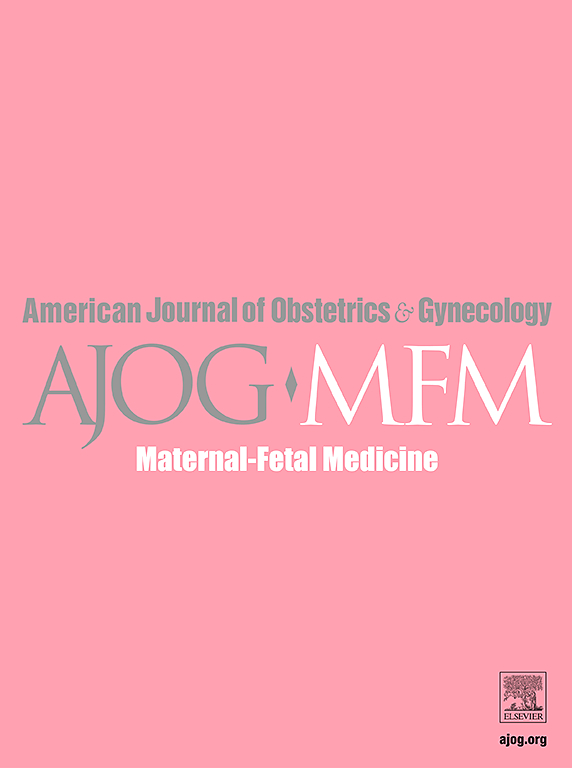新型机器学习在围产期护理中的应用:范围综述。
IF 3.8
2区 医学
Q1 OBSTETRICS & GYNECOLOGY
American Journal of Obstetrics & Gynecology Mfm
Pub Date : 2025-01-23
DOI:10.1016/j.ajogmf.2025.101612
引用次数: 0
摘要
目的:机器学习(ML)是人工智能(AI)的一个分支,它提供了预测建模和动态诊断工具,以促进早期干预和改善决策。考虑到孕产妇、胎儿和新生儿发病率和死亡率的全球挑战,ML具有显著改善孕产妇和新生儿健康结果的潜力。我们的目的是对ML在围产期护理中的应用进行全面的回顾,总结这些工具在提高临床决策和识别新趋势和研究差距方面的潜力。数据来源:我们对MEDLINE、Cochrane Library和EMBASE数据库进行了范围综述,时间从建立到2024年4月。我们通过滚雪球抽样收集了更多的相关研究。我们仔细筛选标题和摘要,并选择全文文章进行进一步分析。研究资格标准:我们纳入了主要的研究文章和摘要,重点关注孕妇,采用ML方法进行围产期护理。研究评价与综合方法:未进行正式的质量评价。使用自定义模板提取数据以捕获研究特征和ML模型。使用汇总表和数字对调查结果进行了综合,以突出主要趋势和结果。结果:406项研究中,78%发表于近5年内。大多数研究来自高收入或资源充足的国家,其中27%来自北美(包括24%来自美国),34%来自亚洲,主要是中国(18%)。来自低收入和中等收入地区的研究明显缺乏,反映出显著的区域差异。预测建模任务最为普遍(59%),其次是分类任务(29%)。监督学习占主导地位(90%),其中最常用的算法是支持向量机、随机森林和逻辑回归。关键主题包括胎儿窘迫和酸血症(32%)、早产(22%)、分娩方式(13%)和出生体重(13%)。值得注意的是,只有19%的研究使用了可解释的人工智能方法,只有5%的研究进行了外部验证。尽管取得了这些进步,但只有1%的模型产生了可访问的临床工具,而且没有一个模型完全集成到医疗保健系统中。结论:ML具有通过提高诊断准确性和预测能力来提高围产期护理的显著潜力。然而,实现这一潜力需要负责任的人工智能实践,包括使用外部数据集进行稳健验证,对不同人群进行前瞻性调查,以及开发数字和数据基础设施,以便无缝集成到电子健康记录中。此外,透明的人工智能可以洞察风险分层逻辑,这对于临床医生对机器学习工具的信任至关重要。未来的研究应该解决研究不足的领域,优先考虑被忽视的低收入环境,并探索先进的ML方法来改善孕产妇和新生儿的预后。本文章由计算机程序翻译,如有差异,请以英文原文为准。
Novel machine learning applications in peripartum care: a scoping review
Objective
Machine learning (ML), a subtype of artificial intelligence (AI), presents predictive modeling and dynamic diagnostic tools to facilitate early interventions and improve decision-making. Considering the global challenges of maternal, fetal, and neonatal morbidity and mortality, ML holds the potential to enable significant improvements in maternal and neonatal health outcomes. We aimed to conduct a comprehensive review of ML applications in peripartum care, summarizing the potential of these tools to enhance clinical decision-making and identifying emerging trends and research gaps.
Data Sources
We conducted a scoping review on MEDLINE, Cochrane Library, and EMBASE databases from inception to April 2024. We gathered additional relevant studies through snowball sampling. We meticulously screened titles and abstracts and chose full-text articles for further analysis.
Study Eligibility Criteria
We included primary research articles and abstracts focusing on pregnant individuals, employing ML methods for peripartum care.
Study Appraisal and Synthesis Methods
No formal quality assessment was performed. Data were extracted using a custom template to capture study characteristics and ML models. Findings were synthesized using summary tables and figures to highlight key trends and results.
Results
Among 406 studies, 78% were published within the last five years. Most studies originated from high-income or well-resourced countries, with 27% from North America (including 24% from the United States) and 34% from Asia, predominantly China (18%). Studies from low- and middle-income regions were notably scarce, reflecting significant regional disparities. Predictive modeling tasks were the most prevalent (59%), followed by classification tasks (29%). Supervised learning dominated (90%), with algorithms such as Support Vector Machines, Random Forests, and Logistic Regression most commonly used. Key topics included fetal distress and acidemia (32%), preterm birth (22%), mode of delivery (13%), and birth weight (13%). Notably, Explainable AI methods were utilized in only 19% of studies, and external validation was performed in just 5%. Despite these advancements, only 1% of models resulted in accessible clinical tools, and none were fully integrated into healthcare systems.
Conclusions
ML holds significant potential to enhance peripartum care by improving diagnostic accuracy and predictive capabilities. However, realizing this potential requires responsible AI practices, including robust validation with external datasets, prospective investigations across diverse populations, and the development of digital and data infrastructure for seamless integration into electronic health records. Additionally, transparent AI that provides insights into risk stratification logic is essential for clinician trust in ML tools. Future research should address understudied areas, prioritize neglected low-income settings, and explore advanced ML approaches to improve maternal and neonatal outcomes.
求助全文
通过发布文献求助,成功后即可免费获取论文全文。
去求助
来源期刊

American Journal of Obstetrics & Gynecology Mfm
Medicine-Medicine (all)
CiteScore
7.40
自引率
3.20%
发文量
254
审稿时长
40 days
期刊介绍:
The American Journal of Obstetrics and Gynecology (AJOG) is a highly esteemed publication with two companion titles. One of these is the American Journal of Obstetrics and Gynecology Maternal-Fetal Medicine (AJOG MFM), which is dedicated to the latest research in the field of maternal-fetal medicine, specifically concerning high-risk pregnancies. The journal encompasses a wide range of topics, including:
Maternal Complications: It addresses significant studies that have the potential to change clinical practice regarding complications faced by pregnant women.
Fetal Complications: The journal covers prenatal diagnosis, ultrasound, and genetic issues related to the fetus, providing insights into the management and care of fetal health.
Prenatal Care: It discusses the best practices in prenatal care to ensure the health and well-being of both the mother and the unborn child.
Intrapartum Care: It provides guidance on the care provided during the childbirth process, which is critical for the safety of both mother and baby.
Postpartum Issues: The journal also tackles issues that arise after childbirth, focusing on the postpartum period and its implications for maternal health. AJOG MFM serves as a reliable forum for peer-reviewed research, with a preference for randomized trials and meta-analyses. The goal is to equip researchers and clinicians with the most current information and evidence-based strategies to effectively manage high-risk pregnancies and to provide the best possible care for mothers and their unborn children.
 求助内容:
求助内容: 应助结果提醒方式:
应助结果提醒方式:


